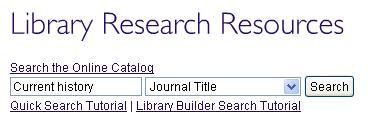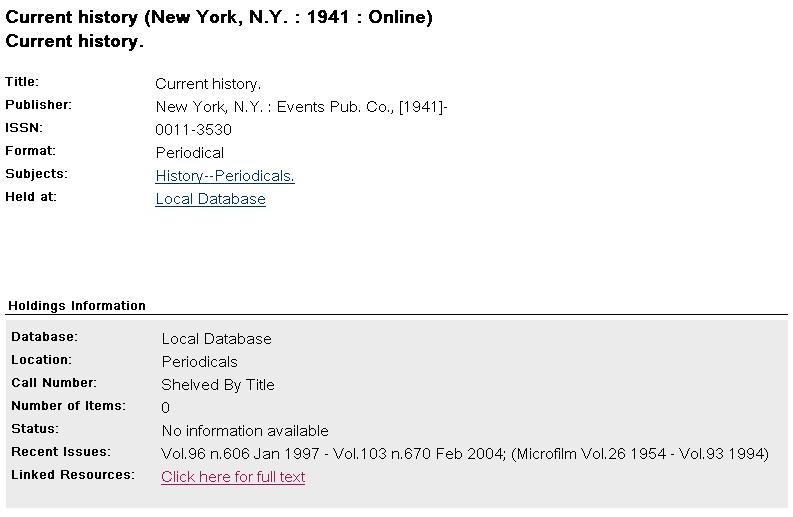Dec
1
It’s already December! That means all of those term papers will soon be due. You’ve been searching the library’s databases quite a bit, looking for current articles for that international relations paper you’re writing on political friction between and North and South Korea. You found a great article in the journal Current History published in September and you need the full text–now:

You’ve clicked on the 360 link, but instead of leading to the article you’re staring at this annoying message: Sorry, no holdings were found for this journal. Please see additional options below for finding this journal. Here’s what to do next:
1. Go the Library Catalog, key in the name of the journal and from the drop-down list, select Journal title.
2. Now, click on Search. This shows you that Current History is available on the shelves and online:
3. The next screen will show you holdings details. Look under Recent Issues and you will see which issues are available in print version in the library. If the issue you need is included in the date range that means you can find this journal on the library’s periodical shelves. (If you need assistance in locating back issues of periodicals, ask for help at the Information Commons desk).
4. Click on Linked Resources: Click here for full text to see if this issue is available full-text online. (You may find an online copy at this step even if the 360 Link did not lead you to the full-text.)

This screen gives us another clue—it informs us that Current History is available full text from 1988 up to 9 months ago. This also solves one mystery—the article you need is not available in full-text because it just came out in September. You will encounter this with some current journals and here’s why: some publishers impose an embargo on the library’s databases (sometimes called aggregator databases) which means that they will not allow them to release the full-text of some journals for up to a year or longer.
That’s all interesting, but you still need the full-text. If you’ve followed the above steps, and the full-text still eludes you, you can request the article through Interlibrary Loan. You can find the ILL link in several places including the page that you encountered after clicking the 360 Link and the Research Resources page. Remember: There isn’t anything you can’t get through the library’s resources and services if you absolutely need it!
Nov
22
 It’s finally Thanksgiving! For most of you it’s a needed respite from studying, papers and the pressure of mid-terms. You’ve done enough serious research on academic topics, so how about researching something fun and carefree—like the Thanksgiving holiday? Let’s do some research on the holiday and the centerpiece of this commemorative day—the turkey. The first stop was the JSTOR database where a keyword search of the terms (thanksgiving AND holiday AND history) retrieves this article: Pleck, Elizabeth. “The Making of the Domestic Occasion: The History of Thanksgiving in the United States.” Journal of Social History 32.4 (1999): 773-74. Here, you’ll learn that Thanksgiving evolved as a “domestic occasion” beginning in the mid-nineteenth century. Next, a search of the Internet Public Library reveals many interesting links including an article entitled Out of This World Thanksgiving from NASA about celebrating the holiday in space. You can also do serious research on turkeys using the Academic Search Premier database. Just go to the Subject Terms guide and key in turkeys and you get some related terms including wild turkeys, which leads to an article entitled Ground Invasion. Reading the abstract, you’ll discover that the East Bay hills in California are being overtaken by—you guessed it—wild turkeys (and pigs!) McGlynn, Daniel. “Ground Invasion.” Bay Nature 10.4 (2010): 18-22. Academic Search Premier. EBSCO. Finally, did you know that this year, the estimated cost is $43.47 for a traditional Thanksgiving feast for 10 people? You can find other interesting statistics about gobblers and Thanksgiving gathered by the Indiana Business Research Center at Indiana University. Enjoy your break and your Thanksgiving feast!
It’s finally Thanksgiving! For most of you it’s a needed respite from studying, papers and the pressure of mid-terms. You’ve done enough serious research on academic topics, so how about researching something fun and carefree—like the Thanksgiving holiday? Let’s do some research on the holiday and the centerpiece of this commemorative day—the turkey. The first stop was the JSTOR database where a keyword search of the terms (thanksgiving AND holiday AND history) retrieves this article: Pleck, Elizabeth. “The Making of the Domestic Occasion: The History of Thanksgiving in the United States.” Journal of Social History 32.4 (1999): 773-74. Here, you’ll learn that Thanksgiving evolved as a “domestic occasion” beginning in the mid-nineteenth century. Next, a search of the Internet Public Library reveals many interesting links including an article entitled Out of This World Thanksgiving from NASA about celebrating the holiday in space. You can also do serious research on turkeys using the Academic Search Premier database. Just go to the Subject Terms guide and key in turkeys and you get some related terms including wild turkeys, which leads to an article entitled Ground Invasion. Reading the abstract, you’ll discover that the East Bay hills in California are being overtaken by—you guessed it—wild turkeys (and pigs!) McGlynn, Daniel. “Ground Invasion.” Bay Nature 10.4 (2010): 18-22. Academic Search Premier. EBSCO. Finally, did you know that this year, the estimated cost is $43.47 for a traditional Thanksgiving feast for 10 people? You can find other interesting statistics about gobblers and Thanksgiving gathered by the Indiana Business Research Center at Indiana University. Enjoy your break and your Thanksgiving feast!
Nov
3
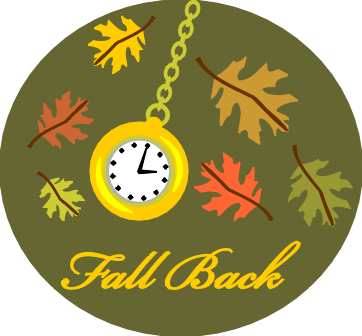
Yes ladies and gentleman, it’s that time again when we change our clocks. On Saturday, November 6, 2010, before you go to bed, remember to turn your clocks back an hour in order to observe Daylight Saving Time (DST). The practice was originally conceived by Benjamin Franklin in order to save on energy costs (extra daylight in the evening means less need for lighting. See parts of his essay with commentary on DST). The idea was later elaborated on by a New Zealand naturalist George Vernon Hudson (read an article about him). DST was followed off-and-on for a long time. For example, during WWI and WWII, as a way to save coal, the U.S. implemented DST but reverted to normal time when the country was at peace. It was not until 1966 that the U.S. Congress passed the Uniform Time Act to standardize the practice even when the country was not at war.
 Today we continue to change our clocks: every March/April we turn our clocks an hour forward and in October/November we turn them back an hour; hence the saying “Spring forward, Fall back”. Even so, there is still a lot of confusion about why and who. Did you know that Arizona, Hawaii, Guam, and Puerto Rico do not observe daylight saving time? I know what you’re thinking: “What!? Why?!” I have to admit, this has also created a lot of confusion for me when calling friends who live in Hawaii or when I’m making a connecting flight in Phoenix (and thinking I’ve missed my flight). The reason: States can opt out of DST/Uniform Time Act. The Arizona State Library, Archives and Public Records has a timeline of DST in the state and why they don’t participate.
Today we continue to change our clocks: every March/April we turn our clocks an hour forward and in October/November we turn them back an hour; hence the saying “Spring forward, Fall back”. Even so, there is still a lot of confusion about why and who. Did you know that Arizona, Hawaii, Guam, and Puerto Rico do not observe daylight saving time? I know what you’re thinking: “What!? Why?!” I have to admit, this has also created a lot of confusion for me when calling friends who live in Hawaii or when I’m making a connecting flight in Phoenix (and thinking I’ve missed my flight). The reason: States can opt out of DST/Uniform Time Act. The Arizona State Library, Archives and Public Records has a timeline of DST in the state and why they don’t participate.
Where and why did I find all of this information?
- I began by looking on the internet (google, wikipedia) and then checking the information that I found with library resources, including electronic encyclopedias in the Oxford Reference Collection and Reference Library-Gale Virtual Reference Library. The encyclopedias included Dictionary of American History and World Encyclopedia. I found the resources by typing in “daylight saving”.
- To get more information, I looked at the library’s database. Ones about American history or sciences (specifically astronomy) were great, including America: History and Life and Science Direct. Similarly, I found the articles by typing in “daylight saving”.
An important part of research is to check a variety of resources for accuracy. Not everything you find (all types of resources – Wikipedia, books, articles) should be taken at face value. It’s always best to evaluate them for reliability, accuracy, currency, etc. Here is a resource to help you with evaluating resources.
Nov
1
 Is your head whirling from the daily barrage of attack ads from the candidates and spin doctors? Do you want nonpartisan information on the gubernatorial candidates and the issues? Then log on to these library databases and recommended web sites for balanced perspectives on the personalities and issues at stake in the 2010 mid-term elections:
Is your head whirling from the daily barrage of attack ads from the candidates and spin doctors? Do you want nonpartisan information on the gubernatorial candidates and the issues? Then log on to these library databases and recommended web sites for balanced perspectives on the personalities and issues at stake in the 2010 mid-term elections:
Gale Biography Resource Center: Read up on Jerry Brown and Meg Whitman and you’ll find some fascinating facts about our candidates for governor in this database. For instance, did you know that Margaret (no wonder she prefers Meg) was once a pre-med major at Princeton, and that she “traded Beanie Babies and Pokemon cards with her children on eBay”? Or did you know that Edmund—yup, that’s Jerry’s actual name—worked briefly with Mother Teresa in India?
CQ Researcher: An excellent source for in-depth articles on politics and current events written by seasoned journalists. Be sure to read this week’s featured report: Democrats’ Future: Will they lose their congressional majorities?
Opposing Viewpoints Resource Center: The perfect database to research different perspectives on an issue. Review the pros and cons of legalizing marijuana, air pollution control or find balanced articles about Meg Whitman and Jerry Brown.
Now, if you want nonpartisan web sites on elections and politics, Prof. Herb Gooch of the Political Science Department steers his POLS 102 students to these sources:
- California Secretary of State (Ballot measures & more)
- California Voter Foundation (Polls, surveys and research)
- California General Election (Ballot measures, etc.)
Happy voting!
Oct
28
With Halloween just around the corner, there’s no better way to impress fellow party goers with your knowledge of Halloween and Halloween-related topics than by learning about the holiday. But why read print books when there are tons of electronic books (eBooks) out there? At the Pearson Library there are several databases where you can find eBooks. Read the descriptions to figure out which one will be best for you.
Here are some books from E-BRARY you can sink your teeth into that will answer your questions about how this holiday has transformed from a day to celebrate the dead, to being a pagan tradition, to becoming a secular holiday. You can find out the significance of jack-o-lanterns, find films about zombies, and read classics like Dracula by Bram Stoker and Frankenstein by Mary Shelley.
Enjoy! And have a scary, fun, and safe Halloween!

Halloween: From Pagan Ritual to Party Night by Nicholas Rogers
In this fascinating study, Rogers shows how the holiday is a hodgepodge of ancient European pagan traditions, 19th-century Irish and Scottish celebrations, Western Christian interpretations of All Souls’ Day and thoroughly modern American consumer ideals. At its heart, he says, Halloween is a celebration of the inversion of social codes-children have power over adults, marauders can make demands of established homeowners and anyone may assume a temporary disguise. One chapter illuminates Halloween and Hollywood, while a chapter entitled Border Crossings discusses Halloween observance among non-Anglo populations in North America, including Mexico’s “Dia de los Muertos.”*
Zombie Movies: The Ultimate Guide by Glenn Kay and Stuart Gordon
For fans of the gory, grotesque, dark-humor-filled world of horror, zombie films may be the most beloved of subgenres. Kay provides a chronological listing, with summary and review, for more than 250 films from 1932 to 2008. Summaries of each decade, interviews with filmmakers, and other features are interspersed, as is a generous complement of promotional photos. A list of the author’s 25 favorite zombie films, an appendix of “zombie-less” zombie films, and a short bibliography follow. Director and film indexes complete the book.*
 Horror Films by Collin Odell
Horror Films by Collin Odell
Often subject to more cuts at the hands of the censor than a serial killer’s razor, the horror film has a fascinating history, not only as film study but also as a look at what has been considered acceptable for the public to view, and what the state will allow its citizens to see. But for the most part horror films are about entertainment—consistently profitable, eminently enjoyable. From horror cinema’s beginnings in the late 19th century to the latest splatter ilms, from the chills of the ghost film to the terror of the living dead, there is more than enough here to keep fans awake at night. Among the many films discussed are the popular Dracula, Evil Dead, Frankenstein, Halloween, Ringu, Scream, and The Sixth Sense, as well as the more unusual Black Cat, The Living Dead Girl, Nang Nak, Rouge, and Les Yeux sans Visage. The guide also profiles such popular directors as Dario Argento, John Carpenter, Wes Craven, David Cronenberg, Hideo Nakata, and Sam Raimi; as well as cult directors from around the world, including Coffin Joe, Jean Rollin, and Michele Soavi.*
From Demons to Dracula: The Creation of the Modern Vampire Myth by Matthew Beresford
In blood-soaked lore handed down the centuries, the vampire is a monster of endless fascination: from Bram Stoker’s Dracula to Buffy the Vampire Slayer, this seductive lover of blood haunts popular culture and inhabits our darkest imaginings. The cultural history of the vampire is a rich and varied tale that is now ably documented in From Demons to Dracula, a compelling study of the vampire myth that reveals why this creature of the undead fascinates us so. Beresford’s chronicle roams from the mountains of Eastern Europe to the foggy streets of Victorian England to Hollywood, as he investigates the portrayal of the vampire in history, literature, and art.*
 Haunted Halls: Ghostlore of American College Campuses by Elizabeth Tucker
Haunted Halls: Ghostlore of American College Campuses by Elizabeth Tucker
Why do so many American college students tell stories about encounters with ghosts? In Haunted Halls, Tucker takes the reader back to school to get acquainted with a wide range of college spirits. Some of the best-known ghosts that she discusses are Emory University’s Dooley, who can disband classes by shooting professors with his water pistol; Mansfield University’s Sara, who threw herself down a flight of stairs after being rejected by her boyfriend; and Huntingdon College’s Red Lady, who slit her wrists while dressed in a red robe. Gettysburg College students have collided with ghosts of soldiers, while students at St. Mary-of-the-Woods College have reported frightening glimpses of the Faceless Nun.*
* All descriptions and covers of the books have been taken from amazon.com and may have been edited.
Oct
14
You found the perfect citation for your paper in one of the library’s databases but it’s not full-text! Now what? No worries. There are a number of steps you can take to easily access the full-text of most citations you find in library databases. This is the first part of a series that will guide you through those steps. If you are searching the EBSCOhost, ProQuest, or WilsonWeb databases, you probably noticed a link at the end of each citation that looks like this:

This is the library’s open URL link resolver and it tries to link you to another database that happens to carry the article. Pretty cool. When it’s successful, it will lead you to a citation or to the actual electronic journal with the full-text. Most of the time this works flawlessly. If the full-text is unavailable, you will see a page that says: “Sorry, no holdings were found for this journal. Please see additional options below for finding this journal.” More on this in a future blog!
Oct
11

Oh, I get by with a little help from my [Information Systems & Services] friends,
Mmm, gonna try [learning a new computer program] with a little help from my friends…
–With a little help from my friends by The Beatles, remixed by ISS
Sometimes all that you need is a little help from knowledgeable computer friends. Want to learn how to use a Mac? Need a little help with Excel? Want to learn a new software? Not a problem! Every month, computer training classes are offered to CLU students, staff, and faculty free of charge. Past topics include: Mail Merge, Powerpoint, Contribute to Manage Your Website, Creating Your Own Account to Take Classes Online, and more. In October, ISS is offering a three part Excel workshop, basic Word and Entourage 2008, and Flashlight workshops. See the Computer Training page for a more information about the classes.
Oct
7
Has this ever happened to you? It’s 10:58am, you’re in the library printing out a paper for your 11am class, the pages print out, you grab them, and run to your class. Hours later, you’re in your dorm room, looking for your thumb drive…only to realize that you had forgotten it at the library earlier in the day? What about this scenario? You’re at a computer, your email is open to an email with an attachment that you sent to yourself so that you can print out an essay. You look at the email and realize that you forgot to send the attachment. What now?

Instead of saving your essay on your laptop, on a thumb drive, or as an email attachment, you can save all of your documents in Dropbox, where you can sync, share, and access your documents from anywhere using any device (laptop, desktop, smart phone, etc.). There are two ways to access Dropbox, either through a client that you have to download or through a web browser (firefox, chrome, internet explorer, safari, etc.). Watch the video for more information. Dropbox is available for free (2 GBs of storage) or as a paid service (unlimited storage).
Accessing and uploading files through a web browser is easy! Click on the “Files” tab, click on the box that says “Upload”, select your file, and there it is!
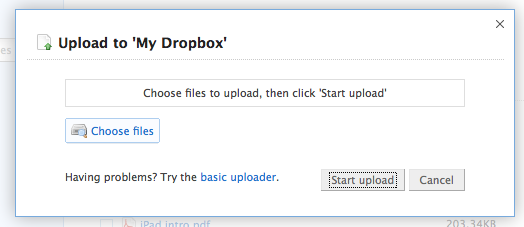
Although Dropbox is great for storage, it is also a tool for group essays or other collaborative projects because you can share the document with others, everyone can edit and re-edit, and previous versions of the document are always available (much like a wiki). Sharing is easy too! Click on the “Sharing” tab, click on “Share a Folder”, select what folder and add in recipient’s email.
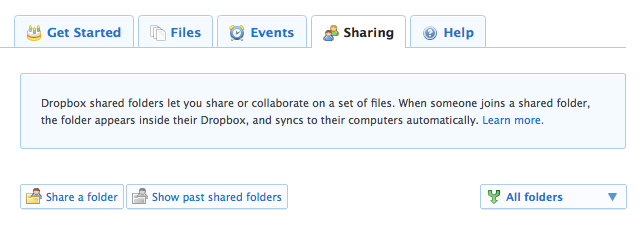
Midterms are coming up and no doubt will you be turning in an essay fora t least one of your classes. Always have your document available by using Dropbox. Sync, share, and store with ease.
Oct
6
Reading through my RSS reader via Google Reader, I came across two articles that you might find interesting. Enjoy!
1. Career Explorer via LinkedIn: LinkedIn announced a tool that they believe can help current college students figure out their career paths or career potential. Read the article to learn more.
2. Handwriting helps the brain, study finds: Handwriting matters not only in terms of communication, but studies have also found that writing something out (rather than typing it out) is better for our brains. Read the article to learn more.
Sep
30

What if you were told that you can’t read the Harry Potter series by J.K. Rowling because it displays too much violence and is therefore unsuitable to the age group? What about Stephanie Meyer’s Twilight series because it is sexually explicit and displays a specific religious viewpoint? And the most ridiculous: What about dictionaries because they are not age appropriate? All of these books and thousands more have been challenged (in other words, someone wants to ban them) or banned from schools, bookstores, and libraries since Banned Books Week started in 1982. The reason for most of the challenges: too sexual or too violent, profanity, offensive portrayals of racial or religious group, and positive portrayals of homosexually. No book is safe as challenges have happened to books from all kinds of genres, contemporary to classics, in every state, and every kind of community. In the case of the dictionaries — Merriam Webster dictionaries were banned in California elementary schools in January 2010 because it defined oral sex, and district representatives felt “it’s just not age appropriate.”
Celebrate your freedom to read during Banned Books Week and throughout the year! Check out the display at the Pearson Library to see what other books have been banned. Look at the Huffington’s Post for their list of the 12 most surprising banned books, and stand up for your right to read whatever you’d like!
